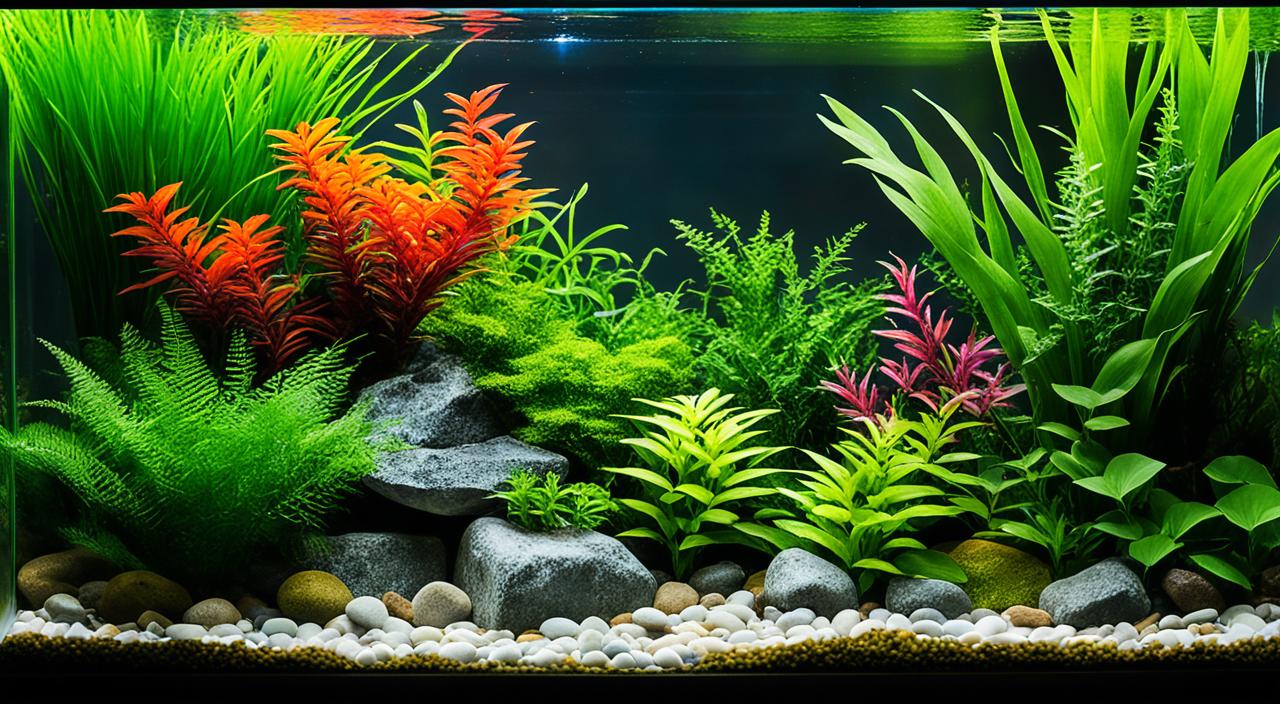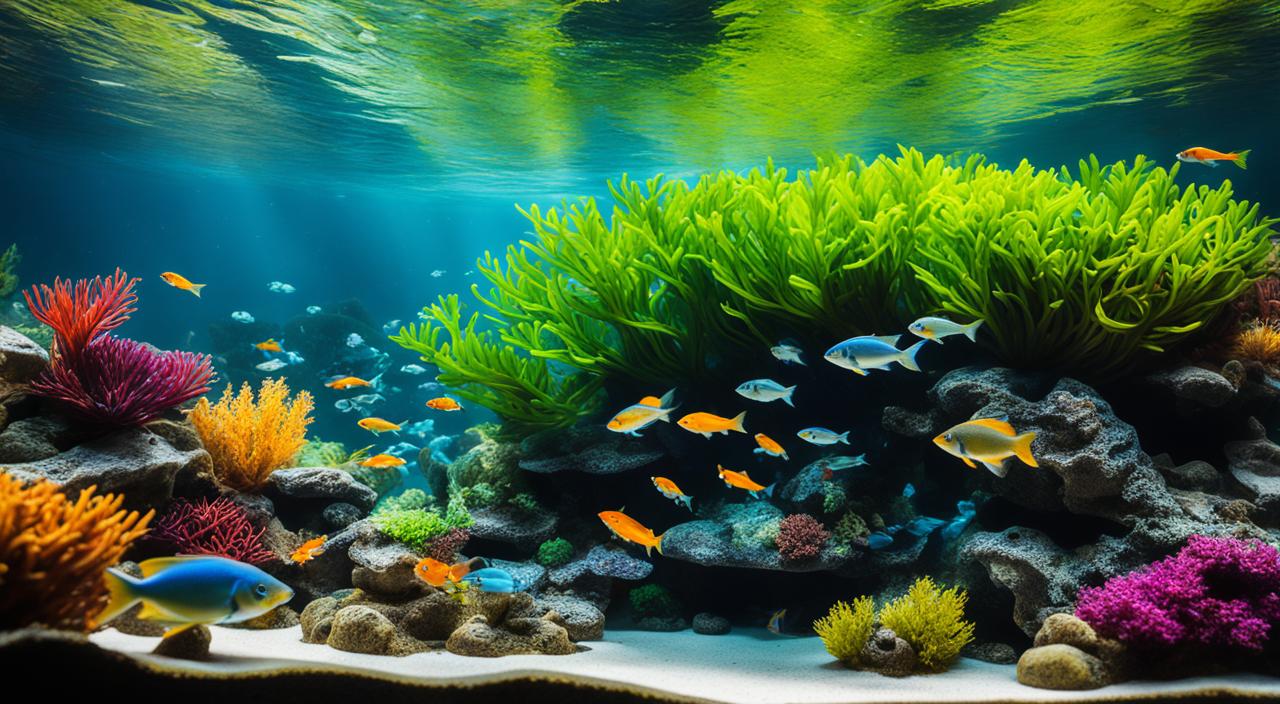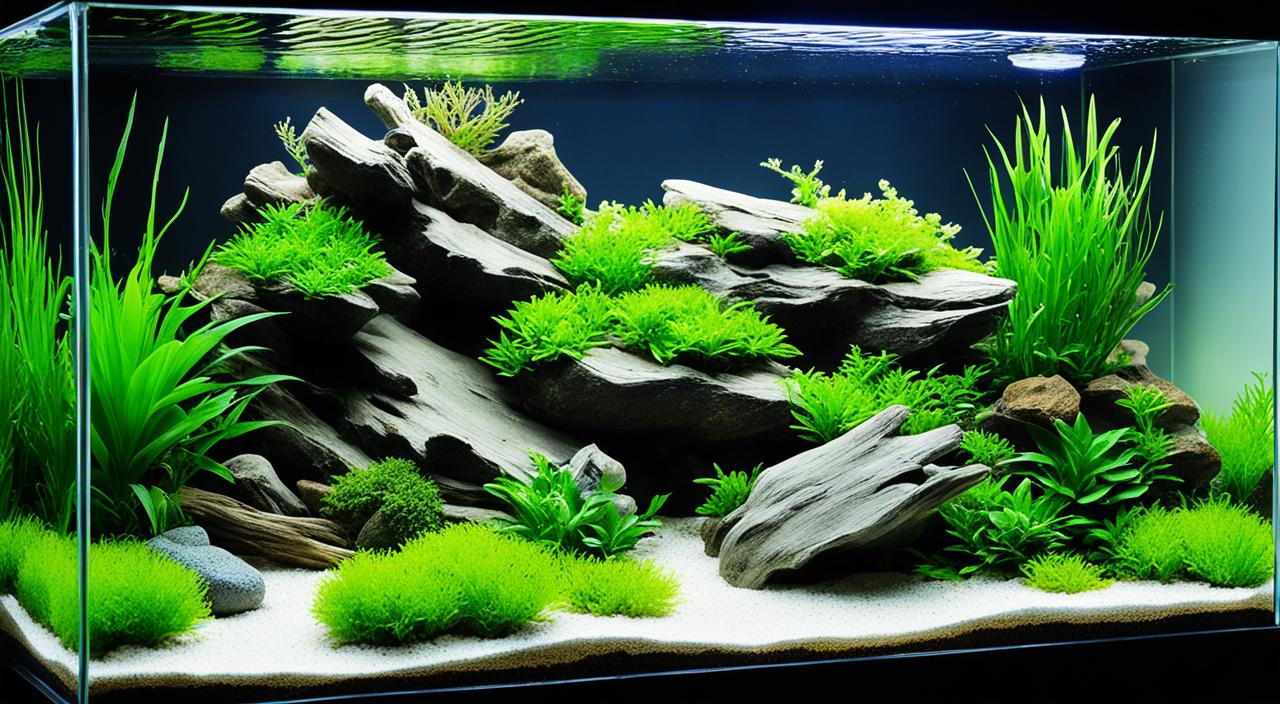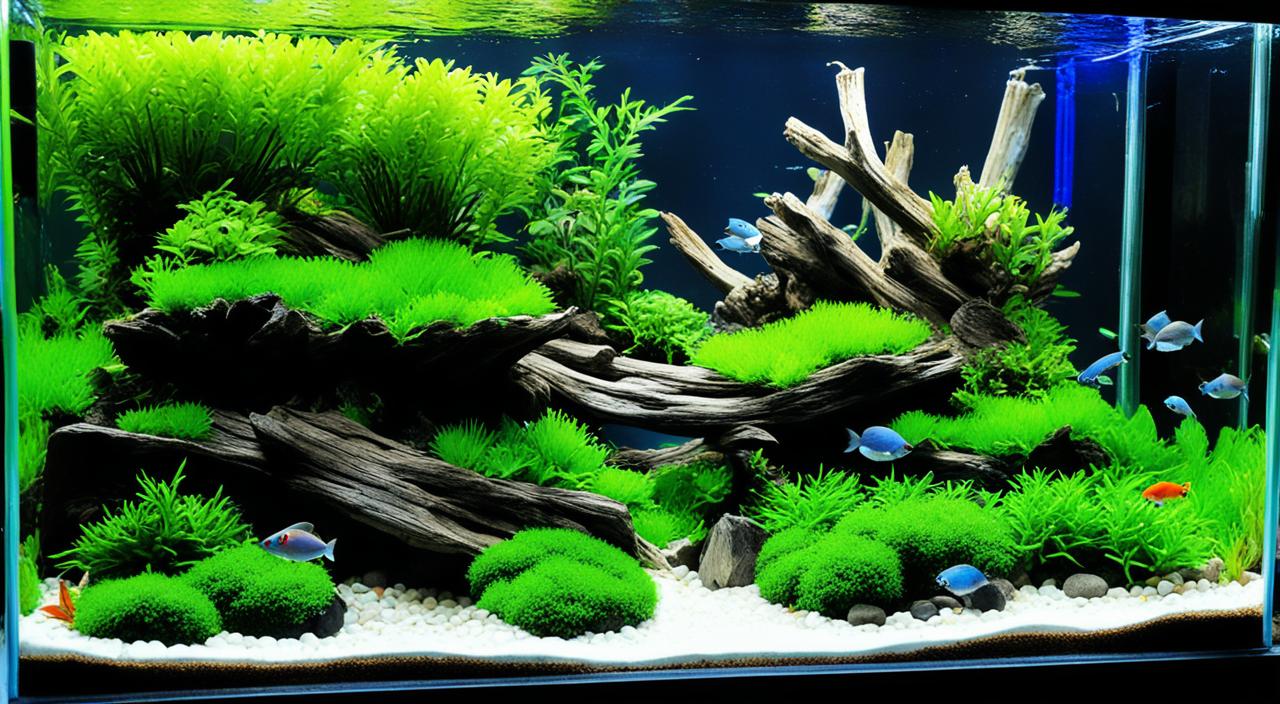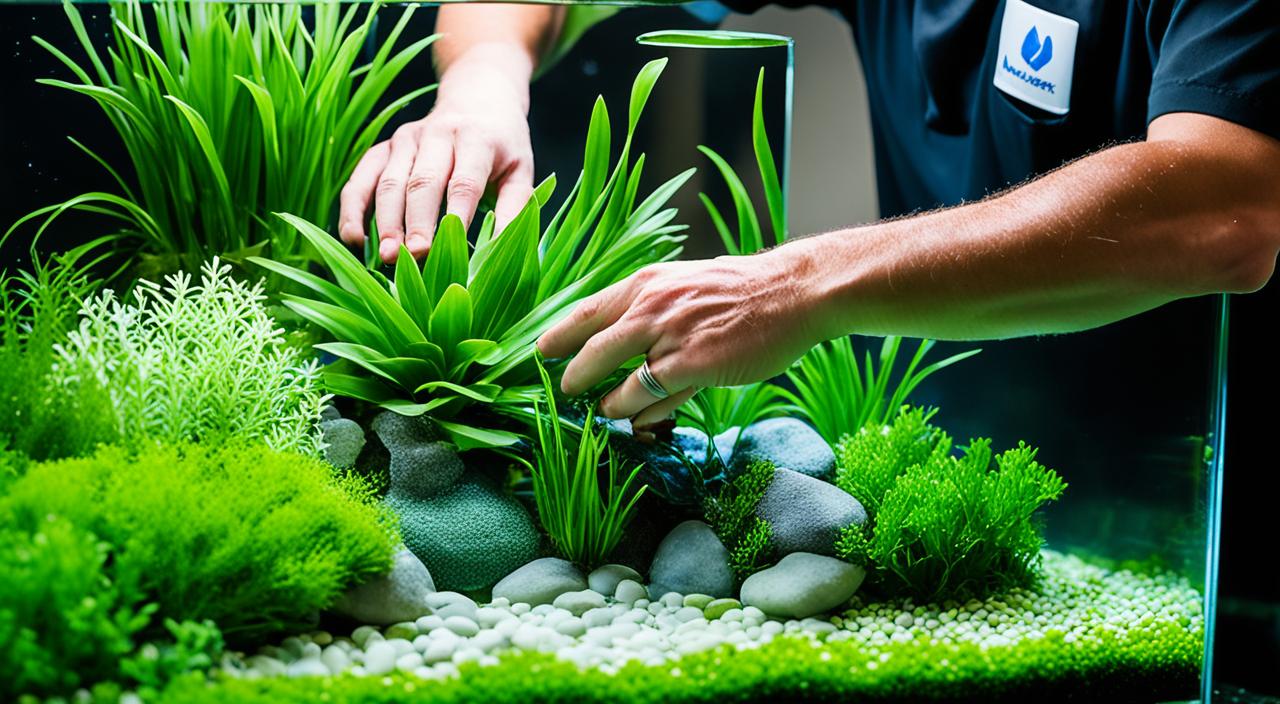Welcome to a world where underwater landscapes come to life. Aquascaping is the art of creating stunning and visually captivating aquariums that mimic the beauty and balance of nature. Whether you’re a beginner or an experienced hobbyist, mastering the basics of aquascaping is crucial to achieving breathtaking results.
When it comes to aquascaping, composition and layout are critical. You can create a harmonious and captivating underwater scene by carefully arranging elements such as plants, rocks, driftwood, and substrate. Understanding the principles that guide aquascaping and equipping yourself with the proper hardware and natural elements is essential for success.
Key Takeaways:
- Mastering aquascaping basics is essential for creating visually appealing underwater landscapes in aquariums.
- Aquascaping involves arranging elements such as plants, rocks, driftwood, and substrate aesthetically pleasingly.
- Understanding the principles of aquascaping, such as simplicity, variety, proportion, and persistence, is crucial for achieving balance and harmony in the tank.
- Essential hardware and natural elements for aquascaping include lighting, water filters, carbon dioxide systems, liquid fertilizers, substrate, and hardscape materials.
- Aquascaping follows specific visual construction and setup rules, such as the rule of thirds and the golden ratio, to create visually appealing and well-balanced aquascapes.
Understanding Aquascaping: What is Aquascaping and its Principles?
Aquascaping is a captivating art that creates visually stunning underwater gardens or landscapes within an aquarium. By strategically arranging elements such as plants, rocks, and driftwood, aquascapers create captivating and aesthetically pleasing aquatic environments.
The fundamental principles of aquascaping guide the creation of these captivating underwater gardens. These principles include:
- Simplicity: Aquascaping emphasizes tasteful arrangements with a minimal number of elements. By embracing simplicity, aquascapers ensure that each component of the aquascape contributes to its overall appeal.
- Variety: Using a diverse selection of plants enhances visual interest within an aquascape. Aquascapes create captivating landscapes that engage the viewer’s senses by incorporating plants of different colours, shapes, and sizes.
- Proportion: Creating balance and harmony is paramount in aquascaping. By carefully considering the arrangement and size of each element, aquascapers ensure that the aquascape has a visually appealing balance and proportion.
- Persistence: Aquascaping is an ongoing process that often involves trial and error. Successful aquascapers are persistent in their pursuit of constantly improving their aquascape. They experiment with layouts, plant combinations, and maintenance techniques to achieve the desired aesthetic.
Aquascaping requires creativity, attention to detail, and an understanding of these principles to create extraordinary aquatic landscapes that mimic the beauty of nature.
| Principle | Description |
|---|---|
| Simplicity | Aquascaping emphasizes tasteful arrangements with fewer elements. |
| Variety | The use of different types of plants creates visual interest. |
| Proportion | A sense of balance and harmony is achieved through careful arrangement. |
| Persistence | Experimentation and willingness to make changes are necessary for continuous improvement. |
Essential Hardware and Natural Elements for Aquascaping
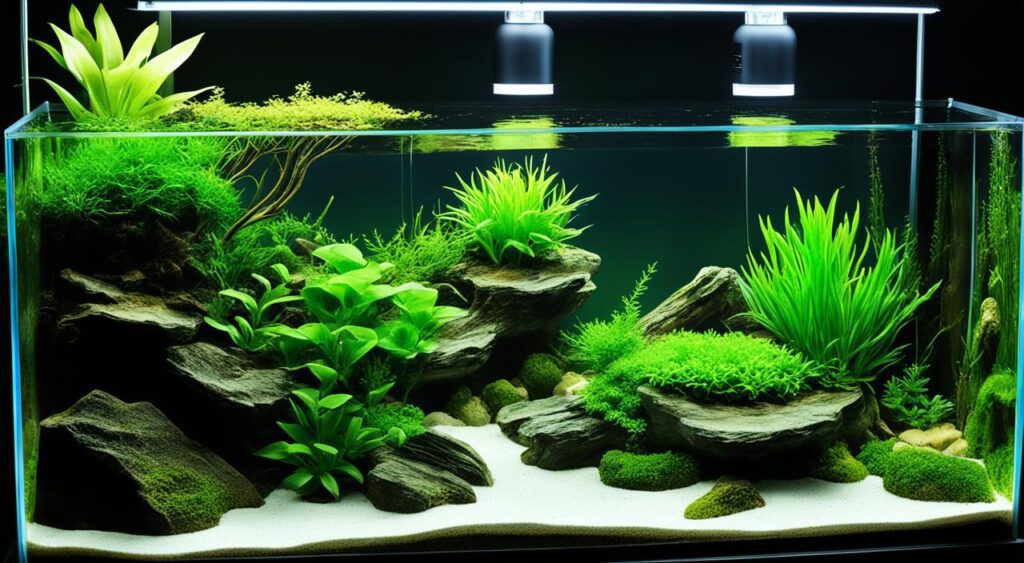
Aquascaping requires several essential hardware and natural elements to create a successful aquascape. These elements play a crucial role in maintaining the health and aesthetic appeal of the underwater landscape.
Aquascaping Lighting
Lighting is a vital component of aquascaping as it directly affects the growth and health of aquatic plants. Proper lighting ensures photosynthesis and helps plants thrive. LED lights are commonly used in aquascaping due to their energy efficiency and adjustable intensity. They come in various spectrums to suit different plant needs, from promoting vegetative growth to enhancing coloration.
Water Filters
Clean water is essential for the overall well-being of the aquarium ecosystem. Water filters remove impurities, such as excess nutrients and debris, that can negatively impact the water quality. By maintaining a balance in water parameters, filters help create a healthy environment for fish and plants. Popular types of filters used in aquascaping include sponge filters, canister filters, and hang-on-back filters.
Carbon Dioxide Systems
Carbon dioxide (CO2) is a vital nutrient for aquatic plants. CO2 injection systems provide an additional source of carbon dioxide, enabling plants to photosynthesize and grow more efficiently. These systems are available in various forms, such as CO2 canisters or liquid carbon supplements, and are crucial for encouraging lush plant growth in aquascapes.
Liquid Fertilizers
Plants in an aquascape require a steady supply of essential nutrients to thrive. Liquid fertilizers offer a convenient and effective way to provide plants with necessary elements like nitrogen, phosphorus, and potassium. These fertilizers are typically added to the aquarium water in prescribed amounts to ensure optimal plant growth and vibrant foliage.
Substrate
The substrate forms the foundation of an aquascape and plays a critical role in anchoring plants’ roots and providing essential nutrients. It also aids in establishing a beneficial environment for beneficial bacteria that help break down waste materials. Common types of substrates used in aquascaping include nutrient-rich soil, gravel, and sand.
Hardscape Materials
Hardscape materials, such as rocks and driftwood, add structure and visual interest to an aquascape. They provide natural focal points and create a sense of depth and dimension. Rocks, like lava rock or dragon stone, can be stacked or arranged to form captivating formations. Driftwood, on the other hand, adds a touch of natural beauty and can be used as a supporting structure for mosses and other plants.
| Essential Elements | Function |
|---|---|
| Aquascaping Lighting | Promotes plant growth through photosynthesis |
| Water Filters | Maintain water quality by removing impurities |
| Carbon Dioxide Systems | Supplies essential carbon dioxide for plant growth |
| Liquid Fertilizers | Provides necessary nutrients for healthy plant growth |
| Substrate | Anchors plant roots and provides essential nutrients |
| Hardscape Materials | Adds structure and visual interest to the aquascape |
Aquascaping: Rules of Visual Construction and Setup
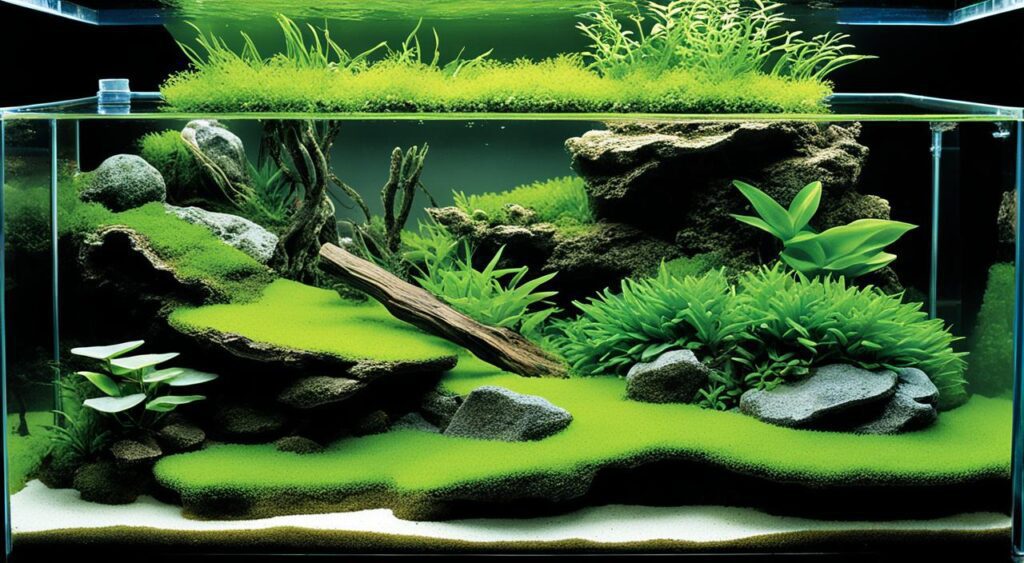
To create visually appealing and well-balanced aquascapes, aquascaping follows certain rules of visual construction and setup. Two important guidelines used in aquascaping are the rule of thirds and the golden ratio.
Rule of Thirds
The rule of thirds suggests dividing the tank into nine equal parts using imaginary lines. This creates a grid that helps determine the placement of elements within the aquascape. The focal point of the aquascape, such as a striking plant or a captivating rock formation, should be positioned at the intersection points of the grid. This placement creates visual interest and draws the viewer’s eye to the focal point, enhancing the overall aesthetics of the aquascape.
Golden Ratio
The golden ratio is a mathematical principle that can be applied to create a visually pleasing composition in aquascaping. It involves dividing a line into two parts in a specific ratio: approximately 1.618 to 1. This ratio is believed to create a sense of harmony and balance in aesthetics. In aquascaping, the golden ratio can be used to determine the size and placement of hardscape elements, such as rocks or driftwood, within the tank. By following the golden ratio, aquascapers can create a focal point that is visually appealing and proportionate to the overall aquascape.
By adhering to these rules of visual construction and setup, aquascapers can create aquascapes that are visually stunning and well-balanced. These guidelines help to create a sense of harmony, guide the viewer’s eye within the tank, and accentuate the beauty of the aquatic environment.
| Rule | Description |
|---|---|
| Rule of Thirds | The tank is divided into a grid of nine equal parts, and the focal point is placed at the intersection points of the grid. |
| Golden Ratio | A line is divided into two parts in a ratio of approximately 1.618 to 1, creating a visually appealing composition. |
Exploring Aquascaping Styles
Aquascaping offers a variety of styles that cater to different tastes and desires. Whether you’re looking to create a lush underwater garden or a wild and untamed jungle, there is a style that will inspire you.
The Dutch style aquascaping focuses on the arrangement and cultivation of aquatic plants, creating intricate and vibrant underwater landscapes reminiscent of a garden. With careful selection and placement of various plant species, the Dutch style creates a harmonious and visually stunning aquascape.
If you prefer a more natural and wild appearance, the Jungle style aquascaping might be your choice. This style aims to recreate the dense vegetation and untamed beauty of a jungle. It utilizes a wide variety of plants, creating a lush, green oasis in your aquarium.
For those who appreciate simplicity and minimalism, the Iwagumi style aquascaping might be the perfect fit. This style places a strong emphasis on rocks as the main elements of layout. With careful placement and a limited number of plant species, the Iwagumi style creates a sense of tranquility and elegance.
Finally, we have the Nature Aquarium style aquascaping, which seeks to create a natural and organic underwater environment that mimics the beauty of nature. This style incorporates a combination of rocks, driftwood, and a diverse selection of plant species to create an aquarium that resembles a slice of the natural world.
Each aquascaping style has its own unique characteristics and requires different techniques and approaches. Whether you choose the vibrant Dutch style, the wild Jungle style, the serene Iwagumi style, or the natural Nature Aquarium style, the possibilities for creating stunning aquascapes are endless.
FAQ
What is aquascaping?
Aquascaping is the art of creating visually appealing underwater gardens or landscapes in an aquarium. It involves arranging elements such as plants, rocks, and driftwood in a way that is aesthetically pleasing.
What are the basic principles of aquascaping?
The basic principles of aquascaping include simplicity, variety, proportion, and persistence. Simplicity emphasizes tasteful arrangements with fewer elements, while variety promotes the use of different types of plants for visual interest. Proportion ensures a sense of balance and harmony in the tank, and persistence is key as aquascaping often involves trial and error and the willingness to experiment and make changes.
What essential hardware and natural elements are needed for aquascaping?
To create a successful aquascape, you will need lighting, water filters, carbon dioxide systems, liquid fertilizers, substrate, and hardscape materials such as rocks and driftwood. Lighting is important for plant growth, filters maintain water quality, carbon dioxide systems support plant growth, liquid fertilizers provide nutrients, substrate anchors plants and promotes root growth, and hardscape materials add structure and visual interest.
What are the rules of visual construction and setup in aquascaping?
The rule of thirds suggests dividing the tank into nine equal parts using imaginary lines and placing the focal point of the aquascape at the intersection points of the grid. The golden ratio involves dividing a line into two parts in a specific ratio to create a focal point. These rules help create a sense of harmony and guide the viewer’s eye within the aquascape.
What are some popular aquascaping styles?
There are several popular aquascaping styles, including the Dutch style, Jungle style, Iwagumi style, and Nature Aquarium style. The Dutch style focuses on the arrangement and cultivation of aquatic plants, creating an underwater garden. The Jungle style aims to recreate the wild and untamed appearance of a jungle, with dense and natural-looking vegetation. The Iwagumi style emphasizes simplicity and harmony, using rocks as the main elements of layout. The Nature Aquarium style seeks to create a natural and organic underwater environment, mimicking the beauty of nature.

